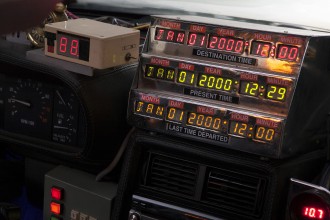Young Scientist
Young Scientist
February 23, 2024By Aileen O’Catherine

Have you ever thought about what it might be like to travel through time? Have you imagined going back to correct a mistake, or to see how you looked as a baby? The movie “Back to the Future” explored this idea through a fictional device called the DeLorean Time Machine, which the character Marty McFly used to go back in time to meet his mother before she had married his father. But is time travel possible outside the world of science fiction?
Time travel is not only possible, it’s inevitable. As you read these words, you’re traveling through time at a rate of one second per second. When the scientist Albert Einstein developed his theory of relativity, he noted that nothing can travel faster than the speed of light. (Light travels through a vacuum at the speed of 299,792,458 meters per second — equal to 983,571,056 feet or 186,000 miles per second). Einstein’s theory also noted that the faster you travel, the slower you experience time, because space and time are linked together. Scientists have proven his theory is correct. In one experiment, scientists set two clocks to the exact same time. One clock stayed on Earth, and the other clock flew in an airplane in the direction of the Earth’s rotation. Scientists compared the two clocks after the airplane had traveled around the world. The clock on the airplane was slightly behind the clock on Earth, meaning the clock on the airplane traveled slower in time than one second per second.
Einstein’s theory also states that gravity curves space and time, which causes time to slow down. This affects our everyday lives. When using navigational maps in our cars or phones to get around town, the information comes to us from GPS (global positioning system) satellites. GPS satellites orbit Earth at 14,000 kilometers (8,700 miles) per hour, a high rate of speed, which slows the satellite clocks down by a fraction of a second. However, remember how gravity curves space and time? Because GPS satellites orbit Earth high above its surface, they zoom around in weaker gravity. (The further from Earth, the weaker the force of gravity). So, the GPS satellite clocks run faster than clocks on the ground, which would make your navigational map show you moving faster than the rate you actually are traveling on Earth. While that would normally mean miles of difference, scientists use mathematics to correct the time differences so they match.
You’ve experienced another kind of time travel if you’ve ever travelled long distances by airplane. Because Earth is curved and not flat like a map, an imaginary north-south line drawn through the middle of Earth at 0 degrees longitude acts as a kind of starting point for measuring distance east and west. This line is called the prime meridian, and by international agreement, it runs through Greenwich, England. The prime meridian also sets Coordinated Universal Time (UTC). All countries measure their time zones according to UTC, and there are 24 time zones in the world. The prime meridian also establishes the International Date Line, which is at 180 degrees longitude (halfway around a 360-degree Earth). If you travel east from New York to Norway, you will go back in time, or lose time, because you’ve crossed six time zones. If you travel west from New York to San Francisco, you will move ahead in time because you will have crossed four time zones.
While we all time travel at the rate of speed of one second per second here on Earth, we each experience it differently. When taking a test, time can seem to drag. A birthday party can seem to go by in a flash. If you could time travel to a different place and time, where and when would that be?




